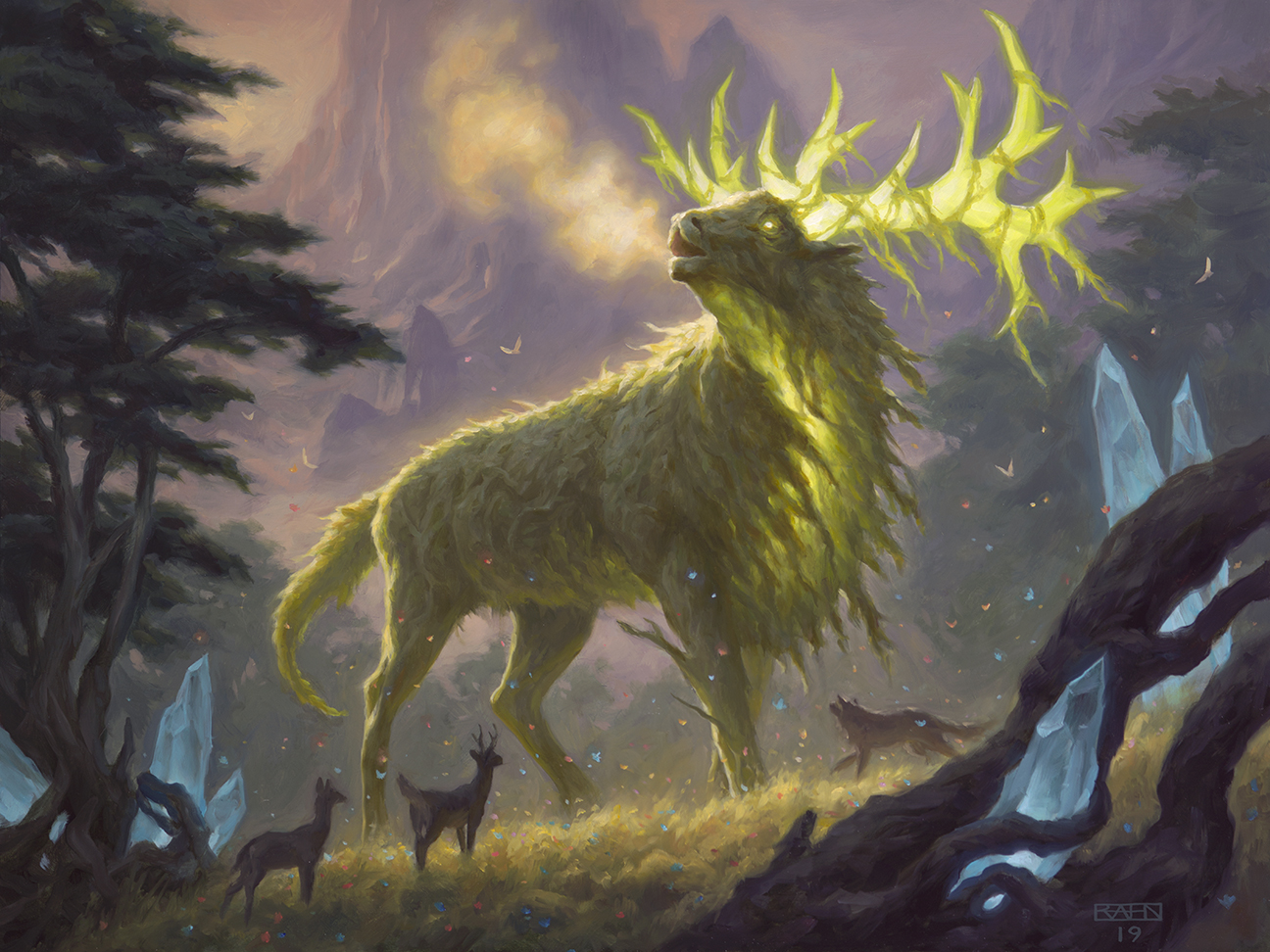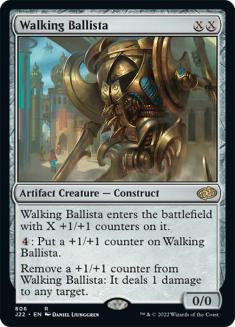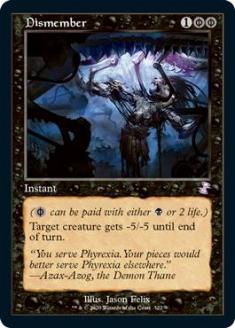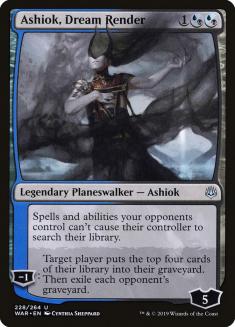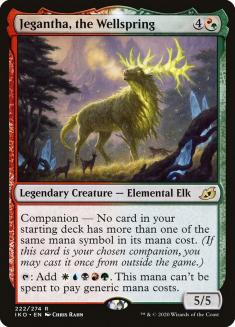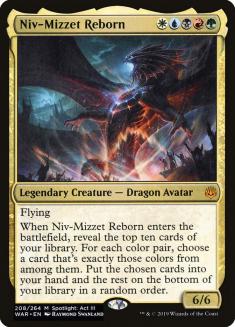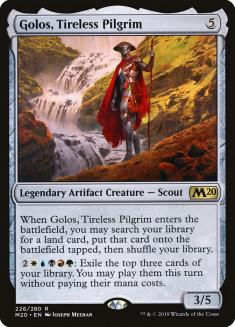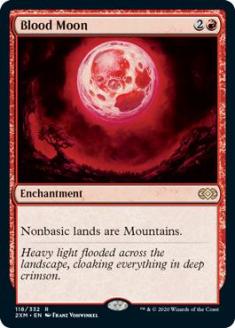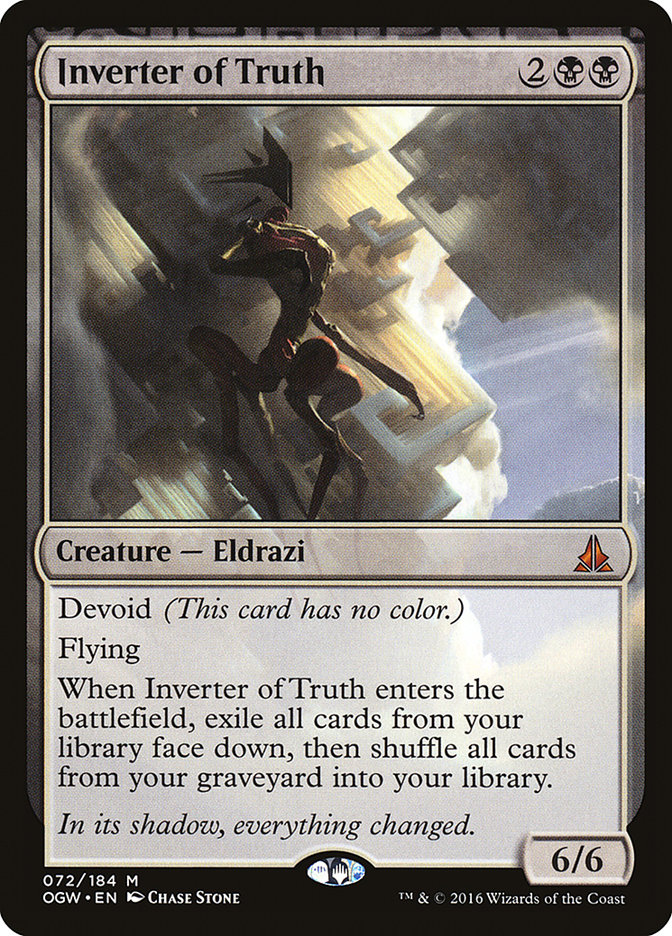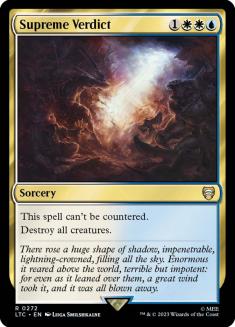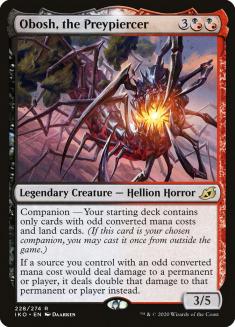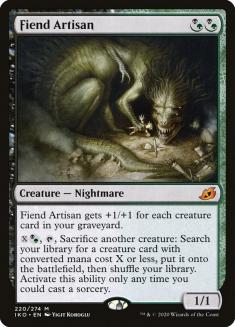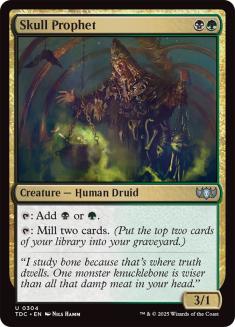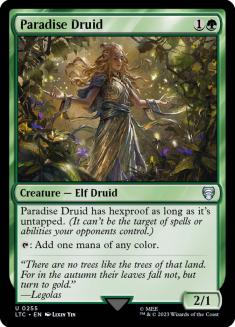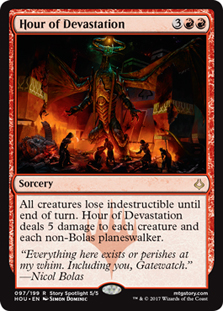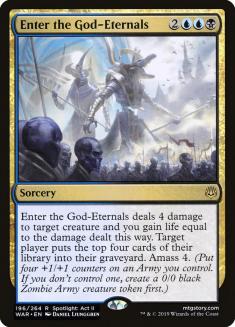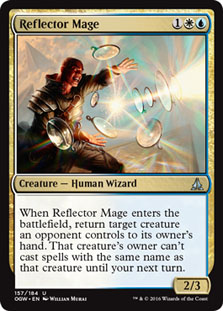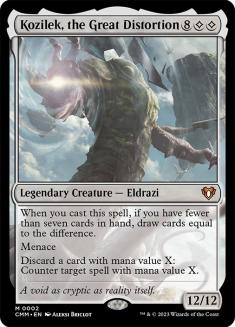Of all the companions we have, Jegantha, the Wellspring is the one that has the lightest restriction — you cannot play any duplicated mana costs. This includes not only the five basic mana costs but basically any mana symbol — if the same symbol is there twice, you cannot play it. This rules out cards like Walking Ballista and Chalice of the Void (X is a mana cost and it’s there twice), as well as repeated Phyrexian mana costs (such as Dismember) or duplicated hybrid symbols (like Ashiok, Dream Render).
It also unfortunately rules out the Arabian Nights Aladdin’s Lamp. RIP.
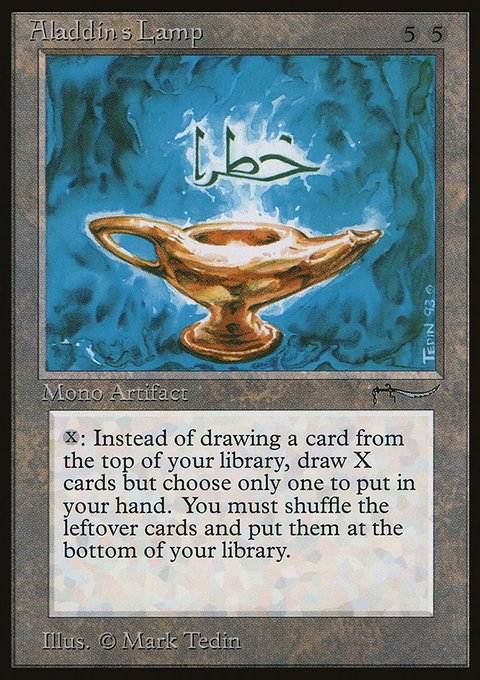
There are several decks, ranging from Standard to Vintage, that naturally conform to the requirement already, with absolutely no changes required to their existing builds. There are also several decks that could accommodate the card with one small change. My goal in this article is to find out what those decks are, and whether it’s worth it for them to play Jegantha in their sideboard.
In return for having the lightest restriction, Jegantha is also the worst companion, which I guess is the only logical way of doing it. A five-mana 5/5 is nothing to write home about, and its ability can add any amount of mana from one to five depending on the cards you have in your hand, which can either be great or irrelevant depending on the game state. All in all, Jegantha is, unlike basically every other companion, a card you will virtually never put in your deck — if you’re playing it, it’s exclusively because it’s free, as it’s not super-powerful and it’s not a build-around. No one really wants access to a Jegantha the same way they might really want access to Zirda, the Dawnwaker; Lurrus of the Dream-Den; or Yorion, Sky Nomad.
As a free card, however, I think it’s better than people give it credit for. Yes, you’d never play a five-mana 5/5, but having a 5/5 creature that can be immune to a lot of the removal played in the format (Fatal Push and Lightning Bolt, for example) can win you a game — just ask anyone who’s ever lost to a Gurmag Angler. In Constructed, there are a lot of games where you flood out and have nothing to cast, or games in which players trade resources and end in a topdeck war, and in these games having access to a 5/5 creature out of nowhere is very valuable.
A lot of the time, you’re not going to be using Jegantha for its mana ability — you do have to tap a 5/5 creature for that, which is a big cost — but when you do use it, it’s going to be very relevant. This card itself already casts a Niv-Mizzet Reborn and then you have all your mana untapped to cast whatever you draw. Remember that you can mix and match it for different spells as well. You can use it to cast Teferi, Time Reveler and Dreadbore, for example. Even if you’re casting Bring to Light, it adds two mana for it, and then you have the remaining WBR to cast whatever you drew. It can also serve to activate abilities (such as Golos, Tireless Pilgrim), or half of the escape cost from Uro, Titan of Nature’s Wrath. Perhaps most important of all, it provides all your colored-mana needs through Blood Moon, and, being a red card, is always castable under it, so it’s the perfect answer for that card out of a multicolored deck.
That said, Jegantha is not exactly “free.” Having Jegantha in your deck, even when it requires no changes to your build, will cost you in three different ways:
1. It costs you a sideboard slot. Some decks have very impactful sideboard options (things like Stony Silence and Rest in Peace), and it is a detriment to have to cut one of these cards. In general, I would say that having access to the 5/5 every game is always going to be more important than a single sideboard slot. The sideboard slot might be more impactful in a specific matchup, but it’s only one card —you have to play against the right deck and then draw your one copy of it. Jegantha is going to be there for you in every game of every match, and you don’t need to draw it. If the only cost is one sideboard slot, I’m relatively confident that you should be playing a Jegantha in any deck that you can.
2. It reveals information to your opponent. This is a bit tricky, because it’s going to play out very differently in a big tournament or outside of it. A lot of major tournaments nowadays give out decklists at the start of every round, so you’re not actually giving up anything by revealing a Jegantha, but for the sake of the argument let’s assume you’re not playing one of those tournaments. At this point, revealing a Jegantha can inform both your opponent’s mulligan and in-game decisions.
Right now, there’s enough up in the air that I do not believe you’re actually revealing much of what you’re playing — there are several completely different decks that could end up playing Jegantha. If you reveal it in Pioneer, for example, your opponent could mulligan thinking you’re playing Five-Color Niv-Mizzet, but you could also be playing Izzet Ensoul, and the mulligan process against these decks is very different from one another. Rather, you’re revealing a lot more about what you’re not playing.
If I start the game with Jegantha, then my opponent cannot necessarily know what I’m playing, but they know that I’m definitely not playing, for example Dimir Inverter or Azorius Control. If they have a hand that’s particularly bad versus these archetypes, they can keep with confidence that I’m not playing one of them. If I reveal Jegantha early on, my opponent can know that I definitely do not have Hour of Devastation or Supreme Verdict in my Five-Color Niv-Mizzet deck, and they could play accordingly. A red deck could potentially reveal Jegantha and then that would rule out Goblin Chainwhirler.
In the end, there are a lot of different small pieces of information you will be giving your opponent when you reveal a companion, and Jegantha is no different – so, even when it’s free, it’s not necessarily free. That said, I believe that most of the time it will still be worth having access to this card every game of every match. Most inexperienced players will not know what exactly to do with this information and most experienced players will meet you in a tournament setting where this drawback is completely nullified by open decklists.
3. It means you cannot play another companion. There are some decks that could reasonably play Jegantha, but any deck that can choose between Jegantha or another companion is going to play the other one — Jegantha is the worst of the ten, after all.
Let’s take, for example, the Rakdos deck from the latest article by Patrick Chapin:
Creatures (24)
Lands (20)
Spells (16)

This deck has zero maindeck cards with duplicated cost, and only one in the sideboard (God-Eternal Bontu). It could easily play Jegantha but instead it’s playing Obosh, the Preypiercer, which is just a better card. Any time you can play another companion, you should do so instead of playing Jegantha.
So, what’s the verdict? I believe the answer is “yes” that having access to Jegantha is a powerful bonus that is definitely worth a sideboard slot, and almost definitely worth the information you give your opponent at the start of the match. It’s also likely to be worth a small change to your deck, but not a large change. It’s definitely not worth giving up any other companion.
So, which decks can play Jegantha, The Wellspring?
Standard
Creatures (27)
- 4 Midnight Reaper
- 3 Rix Maadi Reveler
- 2 Gutterbones
- 4 Priest of Forgotten Gods
- 4 Mayhem Devil
- 4 Cauldron Familiar
- 2 Stonecoil Serpent
- 4 Woe Strider
Lands (25)
Spells (8)

Fabrizio Anteri used this deck to win the MagicFest Online Season 1 Finals last weekend. It currently plays zero cards with duplicated symbols anywhere, so that’s a very easy fit for Jegantha. Unlike Patrick Chapin build, it plays a number of even-costed cards — Priest of the Forgotten Gods, Rix Maadi Reveler, and Stonecoil Serpent in the maindeck and Noxious Grasp, Agonizing Remorse, Epic Downfall, Scorching Dragonfire, and Embereth Shieldbreaker in the sideboard — so you cannot realistically play Obosh, the Preypiercer without meaningful changes. A lot of people play Dreadhorde Butcher in this deck as well, or Kroxa, Titan of Death’s Hunger, and these are both compatible with Jegantha.
The one potential conflict with Jegantha comes from Ikoria: Lair of Behemoths:
Fiend Artisan is potentially a great addition to this deck — it can find your missing pieces, grow big in the late-game and serve as an extra sacrifice effect for Claim the Firstborn and Mayhem Devil. My inclination is that Fiend Artisan will be good enough to actually eschew Jegantha in this deck, but it’s definitely a possibility that it wants to play it.
Creatures (19)
Lands (26)
Spells (15)

You give up Massacre Girl and Casualties of War in the maindeck, but honestly I’m not a big fan of either of these cards right now, so I don’t think you lose much. After sideboard, if you need to bring in Massacre Girl, then you give up Jegantha for those games. I like that Jegantha lets you play cards like Agonizing Remorse and Heartless Act without worrying as much about drawing a ton of air — now, if you just disrupt them a lot early in the game, you’re guaranteed to be able to follow it up with a 5/5 on Turn 5. The mana that it gives you can also be relevant — it doesn’t help sacrificing Clues or using Trail of Crumbs, but it adds potentially three mana per turn, which can be a lot.
I’m not sure whether Skull Prophet is better than Paradise Druid, but I think the extra point of power and the ability to find your Cauldron Familiars in a stalled game are worth more than occasional hexproof and the ability to produce red mana.
Creatures (15)
- 1 Hydroid Krasis
- 4 Niv-Mizzet Reborn
- 2 Kenrith, the Returned King
- 4 Fae of Wishes
- 2 Polukranos, Unchained
- 2 Uro, Titan of Nature's Wrath
Planeswalkers (4)
Lands (28)
Spells (13)

Honestly, I suspect that Keruga, the Macrosage is going to be a better companion for any Fires of Invention deck (since it’s so strong with Fires and Jegantha’s mana ability becomes sort of redundant if Fires is on the battlefield), but Jegantha is the one we can play if we want to play Fae of Wishes. Conveniently, Fae of Wishes gives us access to powerful double-costed cards like Casualties of War, Enter the God-Eternals, and Inspired Ultimatum while still letting us play Jegantha. I also have absolutely no idea how the manabase is supposed to be built but that’s something we can work on in the future.
Overall, it doesn’t seem like Jegantha is going to make many waves in Standard, at least not in current decks — it could, however, see play in new builds such as updated versions of Izzet Phoenix, for example. Standard is also, ironically, the format where a 5/5 for five mana is the worst in as most of the played removal kills it and people can usually go over the top of a 5/5 creature. Right now, Standard is a land of haymakers and not trading resources, so a random 5/5 is less effective. In Pioneer, on the other hand, I think things will be different.
Pioneer
Creatures (25)
- 4 Ornithopter
- 4 Steel Overseer
- 4 Bomat Courier
- 1 Hope of Ghirapur
- 4 Skilled Animator
- 4 Gingerbrute
- 4 Stonecoil Serpent
Lands (21)
Spells (14)
Sideboard

Creatures (32)
- 4 Rattlechains
- 4 Spell Queller
- 4 Selfless Spirit
- 4 Mausoleum Wanderer
- 4 Nebelgast Herald
- 4 Supreme Phantom
- 4 Empyrean Eagle
- 4 Spectral Sailor
Lands (24)
Spells (4)

Both of these decks can just add a Jegantha in their sideboard without having to change anything else, and I strongly believe they should do so, even if the card isn’t particularly good in them.
Creatures (12)
Planeswalkers (6)
Lands (27)
- 1 Forest
- 1 Plains
- 1 Swamp
- 1 Mountain
- 1 Island
- 1 Sacred Foundry
- 1 Temple Garden
- 1 Watery Grave
- 1 Godless Shrine
- 1 Stomping Ground
- 1 Blood Crypt
- 1 Breeding Pool
- 1 Hallowed Fountain
- 1 Sunpetal Grove
- 1 Woodland Cemetery
- 1 Temple of Mystery
- 1 Temple of Silence
- 1 Temple of Plenty
- 1 Temple of Epiphany
- 1 Temple of Malady
- 1 Mana Confluence
- 1 Botanical Sanctum
- 1 Blooming Marsh
- 4 Fabled Passage
Spells (15)

This deck needs to make minimal changes to make Jegantha work — namely, it needs to remove Hour of Devastation and Enter the God-Eternals from the maindeck.
Enter the God-Eternals I can definitely leave behind (I don’t think it’s a super-good card in the maindeck anyway), but losing Hour of Devastation is a tough sell. When I wrote about this deck after Players Tour Brussels, I said that not playing Hour of Devastation was a grave mistake, and it was the card I searched for the most after Niv-Mizzet Reborn. Is it worth losing that for Jegantha?
My inclination is yes. Hour of Devastation is great to search for in some spots, but Jegantha will always be there for you. This is a deck with a ridiculously high amount of mana sources and several reactive spells, so you invariably have games where you play some mana sources, disrupt them a little bit, and then either you don’t draw a big card or they manage to deal with it and you’re on air for three or four turns. With Jegantha, you can just cast a 5/5 creature and the mana that it adds is very relevant here.
You also have to be careful with your sideboarding. Questing Beast, for example, should probably be cut, but I think that overall having Jegantha in this deck is worth it.
Modern
In Modern we have even more decks where playing Jegantha is free:
Creatures (37)
- 4 Meddling Mage
- 4 Noble Hierarch
- 4 Phantasmal Image
- 4 Champion of the Parish
- 3 Thalia, Guardian of Thraben
- 2 Kessig Malcontents
- 4 Mantis Rider
- 4 Reflector Mage
- 4 Thalia's Lieutenant
- 3 Kitesail Freebooter
- 1 Deputy of Detention
Lands (19)
Spells (4)
Sideboard

I’ve heard talk of playing Lurrus of the Dream-Den in Humans, and while Lurrus is definitely a much more powerful card than Jegantha, the costs seem too high to me. You need to give up Mantis Raider and Reflector Mage in the maindeck alone (as well as Kessig Malcontents and Deputy of Detention from this list, though you can live without those), and that doesn’t seem worth it considering you have another companion you can play with no changes.
The only clashes with Jegantha happen in the sideboard (Dismember, Mirran Crusader and Auriok Champion all clash with it). My inclination is that these cards are good enough to keep, so when you do want to sideboard them in, just don’t reveal the Jegantha. All in all, it seems like the card is worth it here, especially for those Noble Hierarch-heavy draws.
Creatures (14)
Lands (20)
Spells (26)

I believe Jegantha meaningfully improves Infect, rather than just being a bonus. Infect has several pump spells and a small amount of fragile creatures, and you often struggle when your opponent kills these creatures and leaves you stranded with the pump spells in your hand. With Jegantha, your Plan B is now a possibility in Game 1. If they kill your Glistener Elves and Blighted Agents, just use your mana creatures to cast a 5/5 and win the game with that. This also improves your sideboarded games since it adds another creature to your deck when you bring in Tarmogoyfs. Of all the decks in this article, this might be the deck that benefits the most from Jegantha.
Creatures (7)
Lands (17)
Spells (36)
- 4 Sleight of Hand
- 4 Serum Visions
- 4 Gifts Ungiven
- 4 Desperate Ritual
- 4 Opt
- 3 Remand
- 1 Repeal
- 1 Empty the Warrens
- 1 Grapeshot
- 4 Manamorphose
- 4 Pyretic Ritual
- 2 Past in Flames
Sideboard

This is another deck where Jegantha is straight-up free other than the one Dismember in the sideboard, and that’s completely replaceable. I believe Jegantha is totally worth it here, since Gifts Storm sometimes has a ton of mana but no action. Black-based decks, for example, will sometimes go after your business spells with their Thoughtseizes, leaving you with your Rituals, and then you can cash them in for a 5/5. Turn 2 Goblin Electromancer, Turn 3 Desperate Ritual + Jegantha isn’t the best curve in the world but it will get the job done versus some people.
Creatures (10)
Planeswalkers (6)
Lands (19)
Spells (25)

Jegantha could be a good card in Mono-Green Tron decks, as it complements their main plan relatively well. Sometimes you cast a Wurmcoil Engine or a Thragtusk and it just isn’t enough to win, but perhaps that plus a 5/5 for five mana would be. There are also the games where they deal with your one big thing and then you’re left with a bunch of mana, and the ability to cast a 5/5 creature there can be useful too.
The one issue here is Walking Ballista; since it has two copies of the same mana cost (in this case X), you cannot play it. I think Walking Ballista is very important for this deck and it’s also impossible to replace — you need something to kill creatures in the early-game that also serves as a mana sink and as a way to trigger Sanctum of Ugin in the late-game. You can play cards that do one of these things (for example Spatial Contortion plays the same role early in the game) but there’s nothing else that can do both. That said, there are versions of the deck that don’t even play Walking Ballista, so you can definitely do it, I just don’t know yet if that’s worth it — I’ll have to test to be sure.
Also keep in mind that Kozilek, the Great Distortion (which this build doesn’t play but that I’ve seen before) is also ruled out, since it has two instances of the colorless mana symbol in its cost.
Creatures (6)
Planeswalkers (6)
Lands (25)
Spells (23)

This deck can easily accommodate Jegantha by removing the one copy of Supreme Verdict (which you can then turn into a Solar Blaze if you’re still interested in a sweeper). The sideboard Ashiok, Dream Render and Wheel of Sun and Moon also clash with Jegantha, so you can then play only one copy of each to find with Glittering Wish or you can accept that when you do sideboard them in, you’re giving up Jegantha. Regardless, it seems like it’s definitely worth having the card in this deck, as it can make great use of the mana on top of the 5/5.
Legacy
There are also some decks that can play Jegantha in Legacy. Both a 5/5 body and the mana should be less impactful there than in the other formats, so it’s probably not worth making any changes to your deck to include Jegantha, but if you can just randomly slot it in, it’s going to be worth it. Unfortunately it clashes with Force of Will, so almost all blue-based decks are out, but there are still some lists that can play it:
Creatures (13)
- 4 Dark Confidant
- 4 Knight of the Reliquary
- 1 Scavenging Ooze
- 1 Leovold, Emissary of Trest
- 2 Plague Engineer
- 1 Uro, Titan of Nature's Wrath
Planeswalkers (3)
Lands (26)
Spells (18)

The card is entirely free in this maindeck, only clashing with Jace, the Mind Sculptor and Leyline of the Void in the sideboard. Jace, the Mind Sculptor is only a one-of and we probably don’t need it, and Leyline of the Void is important enough that you’ll be fine giving up Jegantha any time you need to bring it in.
Overall, Jegantha, the Wellspring is not going to break any formats — it’s not strong enough for that. What it will do is serve as a solid addition to many different decks in many different formats, and in the process it will change how the games are played when these decks are involved. It will take us some time to adjust to the fact that some decks will have access to a free 5/5 on top of what they are already doing, but adjust we must, because this is a card we’ll be seeing for a very long time.

